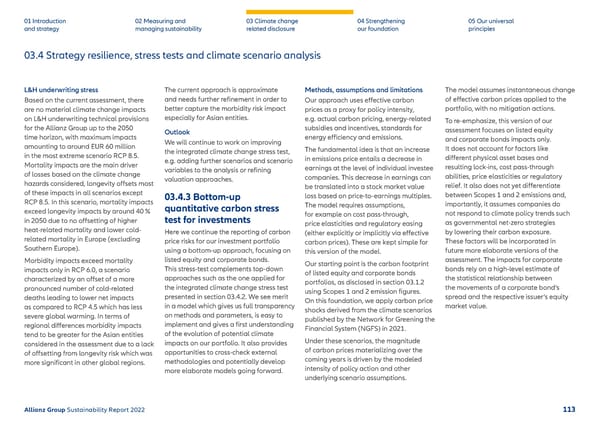01 Introduction and strategy 02 Measuring and managing sustainability 03 Climate change r elated disclosure 04 Strengthening our f oundation 05 Our universal principles L&H underwriting stress Based on the current assessment, there ar e no material climate change impacts on L&H underwriting technical provisions for the Allianz Group up to the 2050 time horizon, with maximum impacts amounting to around EUR 60 million in the most extreme scenario RCP 8.5. Mortality impacts are the main driver of losses based on the climate change hazards considered, longevity offsets most of these impacts in all scenarios except RCP 8.5. In this scenario, mortality impacts exceed longevity impacts by around 40 % in 2050 due to no offsetting of higher heat-related mortality and lower cold- related mortality in Europe (excluding Southern Europe). Morbidity impacts exceed mortality imp acts only in RCP 6.0, a scenario characterized by an offset of a more pronounced number of cold-related deaths leading to lower net impacts as compared to RCP 4.5 which has less severe global warming. In terms of regional differences morbidity impacts tend to be greater for the Asian entities considered in the assessment due to a lack of offsetting from longevity risk which was more significant in other global regions. The current approach is approximate and needs fur ther refinement in order to better capture the morbidity risk impact especially for Asian entities. Outlook We will continue to work on improving the integr ated climate change stress test, e.g. adding further scenarios and scenario variables to the analysis or refining valuation approaches. 03.4.3 Bottom-up quantitative carbon stress test for investments Here we continue the reporting of carbon price risks for our investment portfolio using a bottom-up approach, focusing on listed equity and corporate bonds. This stress-test complements top-down approaches such as the one applied for the integrated climate change stress test presented in section 03.4.2. We see merit in a mo del which gives us full transparency on methods and parameters, is easy to implement and gives a first understanding of the evolution of potential climate impacts on our portfolio. It also provides opportunities to cross-check external methodologies and potentially develop more elaborate models going forward. Methods, assumptions and limitations Our approach uses effective carbon pric es as a proxy for policy intensity, e.g. actual carbon pricing, energy-related subsidies and incentives, standards for energy efficiency and emissions. The fundamental idea is that an increase in emissions pric e entails a decrease in earnings at the level of individual investee companies. This decrease in earnings can be translated into a stock market value loss based on price-to-earnings multiples. The model requires assumptions, for example on cost pass-through, price elasticities and regulatory easing (either explicitly or implicitly via effective carbon prices). These are kept simple for this version of the model. Our starting point is the carbon footprint of listed equity and c orporate bonds portfolios, as disclosed in section 03.1.2 using Sc opes 1 and 2 emission figures. On this foundation, we apply carbon price shocks derived from the climate scenarios published by the Network for Greening the Financial System (NGFS) in 2021. Under these scenarios, the magnitude of c arbon prices materializing over the coming years is driven by the modeled intensity of policy action and other underlying scenario assumptions. The model assumes instantaneous change of eff ective carbon prices applied to the portfolio, with no mitigation actions. To re-emphasize, this version of our assessment f ocuses on listed equity and corporate bonds impacts only. It does not account for factors like different physical asset bases and resulting lock-ins, cost pass-through abilities, price elasticities or regulatory relief. It also does not yet differentiate between Scopes 1 and 2 emissions and, importantly, it assumes companies do not respond to climate policy trends such as governmental net-zero strategies by lowering their carbon exposure. These factors will be incorporated in future more elaborate versions of the assessment. The impacts for corporate bonds rely on a high-level estimate of the statistical relationship between the movements of a corporate bond‘s spread and the respective issuer’s equity market value. 03.4 Strategy resilience, stress tests and climate scenario analysis Allianz Group Sustainability Report 2022 113
 Sustainability Report 2022 | Allianz Page 113 Page 115
Sustainability Report 2022 | Allianz Page 113 Page 115